My students have been having such a fun time with this website. I've uploaded their pictures so they can see themselves as dancing elves.
For those who have goals focusing on imitating motor movements, this is very motivating!
For others who are working on requesting a turn or engaging in conversational turns, it works as a great prompt for that too!
Since I didn't pay the fee to download, we also have worked on the skill of waiting while the web page loads. We've learned words like "loading," "hourglass," "spinning," "we're waiting," "be patient."
ElfYourself
I have created this blog in an attempt to provide a place for teachers and parents of children with special needs to find positive strategies that promote academic, social and emotional growth. I believe in early intervention and in positively addressing both the challenges and strengths of students with disabilities.
Tuesday, December 8, 2009
Saturday, October 24, 2009
Fall Festival
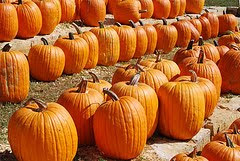
In two weeks, our pre-k classes will be holding our "Fall Festival." This activity is a student, family, and teacher favorite!
The Fall Festival structure uses the same rules and procedures that the children are already familiar with from our rotations in the classroom. (We used a the same lesson structure for our Rodeo Day lessons outlined in another post.)
Fall Festival is organized on a center rotation with a teacher, assistant or parent volunteer assisting at each center. Each center rotation will last 8-10 minutes. Sometimes we have centers last up to 15 minutes, but this year we have a lot of 3 year olds, so we wanted to plan for all children to be successful.
There will be three or four children in a group. (If we add another class or more students, we will increase the centers accordingly. I want a maximum of five children at a center, three or four would be best.) Activities are designed to encourage oral language development, social/emotional development, gross motor development and fine motor development.
Key component: You want to have as many children as possible actively participating in centers at any given time. It is important to practice waiting for your turn, but more active participation at any given time equals less discipline problems. Makes sense...the students are involved in the task rather than getting in trouble.
TIP to spend less money!!!!!!! We hold our fall festival AFTER Halloween. This way the pumpkin patches and grocery stores are very willing to donate pumpkins and hay bales and cornstalks.
Morning Circle:
1) Safety comes first! (hands and feet to self...this includes hula hoops and plastic bowling balls)
2) Stay in your center until the whistle blows
3) Listen to the staff and volunteers
Centers:
Pumpkin Toss
Set up:
~Gather 6 hula hoops
~Place up to 10 or 12 pumpkins spaced apart so that a hula hoop could go around it.
~Get four carpet squares. Each child sits/stands on a carpet square. We place two in one "line" behind a set of three hula hoops and two carpet squares in another "line" behind a set of three hula hoops. It visually cues the children on where they need to be. (Every child in a group should should have a carpet square to stand on while they are playing or waiting.)
Play:
~The child sitting on the carpet square closest to the pumpkin patch tries to throw the hula hoop around the a pumpkin.
~After the turn is completed, the child who was on the "waiting square" moves up to the "throwing square" for his/her turn. The child who was throwing moves to the "waiting square" to wait for another turn. This step is important because it teaches children how to wait, but they don't have to wait for very long. When you have two lines at each center like this you have at least 50% of the class actively participating at any given time. Remember: more children actively participating in the lesson equals less discipline problems.
~Repeat until the whistle blows. The first whistle blow is the cue to "clean up". After the clean up whistle, we have children point to their next center. The second repetetive whistle blow is "move to the next center". Since today is Fall Festival Day, we will "fly like crows" to our new centers.
Benefits:
Practice social/emotional skill of taking turns. We also encourage the children to cheer for their friends while they are waiting. This helps the give compliments and recognize achievements of others. Throwing movement naturally requires students to cross their midline. Great opportunities for oral langauge. 50% of the children are actively engaged at any time.
Fall Sensory Table:
Setup:
~We have two sensory tables we are using. One is based on the "fall sensory tub" video (scroll down and look for the title) from www.Childcareland.com. The other is filled with rice and vegetables from our housekeeping center.
~If you don't have a water table, Home Depot or Lowes have mixing tubs in the concrete/masonry area that would work. They look similar to this, but I have seen others for $6 or $8.
~Gather 4 or more scooping tools or tongs tools. (Our favorite tool for the fall flowers is the popcorn fork.)
Play:
~Let students scoop and explore.
~Move flowers and pumpkins or vegetables to a "safe spot" with tongs, the popcorn fork or "cheater chopsticks."
~Repeat until the whistle bows. Clean up and get ready to "fly like a crow" to a new center.
Benefits:
Great sensory activity. The practice with the tongs and cheater chopsticks exercise the muscles needed for writing and cutting. Lots of opportunities for oral language. 100% of the children are actively engaged the whole time.
Pumpkin Dip
Setup:
~Gather mix items: Cool Whip, pumpkin pie mix, vanilla pudding, gingersnaps or apple slices. (We use this recipe from cooks.com). Also get juice boxes so students can have a drink.
~Create a picture recipe.
~Gather a bowl, a spoon, small cups or bowls and a box of baby wipes.
Play:
~Have students clean their hands with baby wipes since soap and water won't be available. ~Have students "read" the recipe with you.
~Have students add ingredients and stir the mix.
~Eat the pumpkin dip with gingersnaps or apple slices and drink a juice box.
~Enjoy until the whistle blows.
Benefits:
Students practice early literacy skills when reading the recipe. Students follow a sequence of directions. Students get a chance to cool off and have a less active center. 100% of the children are actively engaged the whole time.
Build a Scarecrow:
Setup:
~Gather enough materials so that each group can make a complete scarecrow. We use: old newspaper for stuffing, jeans/overalls, button-down long-sleeved shirts, boots, gloves, hats, large brown grocery bags previously colored orange with a face drawn on it and stuffed with newspaper to create a head, string.
~Before Fall Festival use the string to tie the ends of the sleeves and bottom of the shirt, and the ends of the pant legs so your newspaper stuffing won't fall out.
~Sort all of the materials into piles of pants, shirts, hats, etc. Let students take turns picking each part of their scarecrow.
~This year since we are reducing our time to 8-10 minutes, I will have the shirts already stuffed and have the students stuff the pants and put the scarecrow together.
Play: ~Children build scarecrow with help.
~Children crumple newspaper and stuff the pants and shirts. They choose the materials to create their scarecrow as a group.
~Because this center has a task that needs to have a clear start and finish, we use this center to time the rest of the centers. The person who is leading this center gives the one minute warning for the other centers and blows the whistle when it is time to move.
Benefits: Gross motor and fine motor skills in crumpling the newspaper for pre-writing. Many, many opportunities to develop oral language skills (colors, body parts, clothing items, choices).
Corn Bowling:
Setup:
~Before Fall Festival Day, have students color a coloring page that has an ear of corn, cut out and laminate if possible.
~Gather 2 plastic bowling sets. (We use old ones from a garage sale. The Oriental Trading is the least expensive one I've found.)
~Tape the coloring sheets of the corn to the bowling pins.
~Use painters tape to mark the spots where your bowling pins will stand. This will make set up over and over much, much easier.
~If possible use hay bales as a back stop for the pins and bowling balls.
~Gather 4 carpet squares.
~We make two bowling lanes.
Play:
~Children stand on the "bowling" carpet square or the "waiting" carpet square.
~The child whose turn it is to bowl, rolls the ball towards the pins to knock them down. (We usually give 2 turns.)
~When his/her turn is over he/she moves to the waiting square and the next child gets a turn.
Benefits:
Gross motor skills and oral language skills. Social skills and turn taking. At this center we really encourage the children to cheer for their friends and give compliments or high fives.
photo courtesy of Tigerlily 09 at Flickr Creative Commons.
Friday, October 23, 2009
Tuesday, October 20, 2009

This site was sent through one of the Yahoo groups I belong to. I love it! My students and I used it on the Activeboard today as a "sponge" activity while we were waiting for our OT to come in to start our writing rotation.
Visual Dictionary
photo courtesy of chrishoward at Flicker Creative Commons
Monday, October 19, 2009
Pumpkin Template

Disney has a free, interactive pumpkin template.
We use this on our ActiveBoard to work on choice making, turn taking and language skills.
The vocabulary we work on using this lesson is: pumpkin, jack-o-lantern, eyes, nose, mouth, change, arrow, same, different, shape.
After each child completes a template we print them and save them for a coloring task later.
Photo courtesy Tigerlily 09 at Flickr Creative Commons
Thursday, October 1, 2009
Memorable Moment #7: Dragging/Dragon
Wednesday, July 29, 2009
Easy Adaptable Books
Patrick at Teaching All Students has a great description about how to make an easy adaptable book for your students. Check it out.
My Dining Room.....

Does this look familiar to anyone? I bet I'm not the only one!
This is what my dining room has looked like for the past two weeks. A few things have contributed to this disaster. I boxed up materials I would need for ESY for myself and let 2 other friends borrow materials for their ESY classes, too. I'm moving to a new elementary school in the fall and although ESY has ended, now I need to wait a little bit longer to give the custodians a chance to do their "deep clean" on my new room.
Thank goodness I have an understanding husband and a table in our breakast nook!
Wednesday, July 15, 2009
How to Become More Tech Savvy this Summer
I found this article through one of the CEC SmartBriefs. I thought it was worth sharing.
How to Become More Tech Savvy This Summer
How to Become More Tech Savvy This Summer
Monday, July 13, 2009
Stuart Brown: Play is More Than Fun
Another excellent video from TED focusing on play. This is a talk from Stuart Brown explaining his evidence of play in animals and people. He contends that play is a biological process that is necessary (just as sleep is a biological process that is necessary.) Check it out.
Sunday, July 12, 2009
Tim Brown: Creativity and Play
I found this video on the TED site. I thought it was going to be geared towards education and discovery learning. Turns out it's about play as an important part of thinking as an adult. Tim Brown does a wonderful job connecting some of the elements of play and how they translate in the business and design world. If you've ever wanted a talk that validated play as an authentic learning and thinking experience, this is one to watch.
Tips for Addressing Challenging Behavior
The University of Minnesota has a website that has great Tip Sheets for addressing challenging behavior in the classroom.
I particularly like the ones on "choice making" and "requesting a break." These are two very powerful strategies that can be embedded into almost any learning task.
I particularly like the ones on "choice making" and "requesting a break." These are two very powerful strategies that can be embedded into almost any learning task.
Tuesday, June 30, 2009
Word Bank and Writing Strategy
This summer I have been working with a group of kindergarten through third grade students who have autism. Several of the students have writing goals that need to be addressed and all of them have expressive language goals that need to be addressed. If you have read any of my previous posts, you know that I am a big fan of digital photos to build play skills, critical thinking skills and oral language skills.
Since I find the digital photos so beneficial, I decided to pair that strategy with a manipulative word bank in the hopes of having my students build sentences that they would copy to create a simple paragraph. My goal was that they would build one topic sentence and two detail sentences. We started with modeling and a lot of physical prompts, but I'm hoping the level of prompting will decrease.

Here's what we did:
1) I printed several photos featuring sea life from www.flickr.com.
2) Each student chose a picture that we glued to a large sheet of construction paper.
3) The students were given a file folder with a word bank targeting words that made sense with their picture. (I met with their SLP and we color coded the post its to correspond with the colors and word categories that they already use on their manual communication boards based on Gail Van Tatenhove's system.)
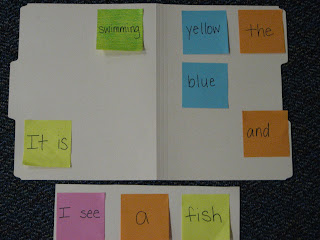
4) Then the students built a sentence by moving the post its to a sentence strip (the sentence strip is just length of file folder cut down).
5) Next the students copied their sentence on a pre-cut piece of paper. (I did this to to visually define the space of the sentence for them. This way the letter spacing and formation is confined to an area that already "looks" like a sentence. )
6) Then they glued the sentence to the piece of construction paper to which we had previously glued their photo choice.
7) We cleared off the sentence strip and started to build another sentence and repeated the steps.
Here's what our first writing samples look like:
Since I find the digital photos so beneficial, I decided to pair that strategy with a manipulative word bank in the hopes of having my students build sentences that they would copy to create a simple paragraph. My goal was that they would build one topic sentence and two detail sentences. We started with modeling and a lot of physical prompts, but I'm hoping the level of prompting will decrease.

Here's what we did:
1) I printed several photos featuring sea life from www.flickr.com.
2) Each student chose a picture that we glued to a large sheet of construction paper.
3) The students were given a file folder with a word bank targeting words that made sense with their picture. (I met with their SLP and we color coded the post its to correspond with the colors and word categories that they already use on their manual communication boards based on Gail Van Tatenhove's system.)

4) Then the students built a sentence by moving the post its to a sentence strip (the sentence strip is just length of file folder cut down).
5) Next the students copied their sentence on a pre-cut piece of paper. (I did this to to visually define the space of the sentence for them. This way the letter spacing and formation is confined to an area that already "looks" like a sentence. )
6) Then they glued the sentence to the piece of construction paper to which we had previously glued their photo choice.
7) We cleared off the sentence strip and started to build another sentence and repeated the steps.
Here's what our first writing samples look like:
Tuesday, June 23, 2009
Water and Sea Life Printable Books
I've been going through my links, looking for materials for our water and sea life theme for summer school. I've found the following free books that can be printed.
Sink or Float Printable Emergent Reader
Pirate Number Word Printable Emergent Reader
I Love to Go to the Beach Printable Emergent Reader
At the Beach with the Bears Printable Emergent Reader
Red Crab, Red Crab What Do You See Printable Emergent Reader
Under the Sea free Interactive Book
Sink or Float Printable Emergent Reader
Pirate Number Word Printable Emergent Reader
I Love to Go to the Beach Printable Emergent Reader
At the Beach with the Bears Printable Emergent Reader
Red Crab, Red Crab What Do You See Printable Emergent Reader
Under the Sea free Interactive Book
Friday, June 19, 2009
Scatman Video about Stuttering
Another video that my husband found and forwarded to me.......
Here are some other links and information about John Scatman.
Wikipedia Information
Lyrics posted on the Stuttering Forum
Interview script
Here are some other links and information about John Scatman.
Wikipedia Information
Lyrics posted on the Stuttering Forum
Interview script
Tuesday, June 9, 2009
Water and Sea Life...Bloom's Box

A few years ago I was in a class that focused on differentiation and levels of knowledge. One fo the strategies the instructor shared was to create a "Bloom's Box" for assignments related to an organizing theme.
A Bloom's Box helps the teacher ensure that s/he is providing instruction at both the lower levels of understanding and at the higher levels of thinking. Essentially, a table is created labeled with each level of Bloom's taxonomy and assignments are sorted into appropriate categories. It helps the teacher make sure there is a balanced experience for all learners.
I'm going to use my Bloom's Box this summer for our Water and Sea Life Unit I have planned.
You can download my Bloom's Box here.
The following is just a list of the activities included in my Bloom's Box.
Knowledge
Students will name pictures of different bodies of water. (river, lake, pond, ocean, waterfall).
Students will name pictures of actions people can do with water (wash your hands, brush your teeth, take a bath, swim, play at the water table, drink, water plants, wash cars, ski, snorkel, boating).
Students will name pictures of sea life (sea star, shark, fish, stingray, jellyfish, manatee, urchin, sea anenome, dolphin, crab, lobster).
Comprehension
Alive/Not Alive Chart
Students will sort pictures of various familiar objects, people, animals and plants on a t-chart according whether the picture is something that is alive or not alive.
Comprehension questions
Students will answer “wh” about familiar stories and classroom activities.
Wants/Needs Action Chart:
Students will sort pictures of previously learned action words into categories of actions we need and actions we want to do.
Application
Class Aquarium
After reading the no-fiction trade book, “What’s It Like to be a Fish?” using Boardmaker icons and pictures, students will create a list of items needed to create a classroom aquarium.
Class Hermit Crab Habitat
After reading the book “A House for Hermit Crab,” using Boardmaker icons and pictures, students will create a list of items needed to create a hermit crab habitat.
Analysis
Compare and Contrast
Students will compare and contrast the homes of a sea creature of their choice with their home using Boardmaker icons, pictures and a pre-made Venn Diagram.
Compare and Contrast
Students will compare and contrast what we used to make our fish aquarium and what we used to make our hermit crab habitat using Boardmaker icons, pictures and a pre-made Venn Diagram.
Synthesis
Students will use supplies generated from their lists to assemble our class aquarium.
Class Hermit Crab Habitat
Students will use supplies generated from their lists to assemble our class hermit crab habitat
Evaluation
If I could be…
Students will draw a picture of any sea creature they would want to be. They will dictate which animal they chose and why they chose it.
Water Hole
Before reading the ending to the story, students will predict what will happen to the animals and the plants if it never rains again.
Personal Needs:
Students will draw a picture of any sea creature they would want to be. They will dictate which animal they chose and why they chose it.
Water Hole
Before reading the ending to the story, students will predict what will happen to the animals and the plants if it never rains again.
Personal Needs:
Students will predict and dictate responses of what would happen if we didn’t have water to wash our hands or brush our teeth.
Saturday, June 6, 2009
Interactive Games Sea Life and Water
Olivia of the Deep (skill: visual motor, visual perceptual)
Diego's Underwater Adventure (skill, sea life vocabulary, visual motor, multiple steps)
Diego's Tuga the Sea Turtle (skill: visual motor, classifying food/not food)
Dora's Mermaid Adventure (skill: visual motor)
Dora's Treasure Hunt (skill: visual motor)
Blue's Clues Sink or Float (skill: concept of sink or float)
Wubbzy's Underwater Adventure (skill: visual motor, harder keyboard controls)
Wonder Pets Save the Penguin or Dolphin (skill visual motor)
Wonder Pets Save the Sea Creatures (skill: visual motor)
Backyardigan's Pirate Adventure (skill: visual motor, visual perception)
Doodle Pad Explore the Seashore (skill: creativity)
Ebb and Flo Hide and Seek (skill: mouse clicks and exploration)
Ebb and Flo Spot the Differences (skill: visual perception)
Build A Fish (skill: fish habitats, creativity)
Fish Counting up to 10 (skill: number concepts)
Clifford Slide (skill: Matching colors)
Seashore Concentration (skill: visual memory)
Build A Habitat (skill: creativity and fine motor)
Barney Submarine Race (skill: visual motor)
Donald Duck Fishing (skill: color recognition and visual motor)
Little Einstein's Orchastra Ocean (skill: instrument sound recognition and matching)
CyberChase Can You Fill It (skill: exploring liquid volume)
Curious George Day at the Beach (skill: multiple steps, visual perception)
Bunnytown Pirates (skill: number order, positional concepts, visual motor)
Diego's Underwater Adventure (skill, sea life vocabulary, visual motor, multiple steps)
Diego's Tuga the Sea Turtle (skill: visual motor, classifying food/not food)
Dora's Mermaid Adventure (skill: visual motor)
Dora's Treasure Hunt (skill: visual motor)
Blue's Clues Sink or Float (skill: concept of sink or float)
Wubbzy's Underwater Adventure (skill: visual motor, harder keyboard controls)
Wonder Pets Save the Penguin or Dolphin (skill visual motor)
Wonder Pets Save the Sea Creatures (skill: visual motor)
Backyardigan's Pirate Adventure (skill: visual motor, visual perception)
Doodle Pad Explore the Seashore (skill: creativity)
Ebb and Flo Hide and Seek (skill: mouse clicks and exploration)
Ebb and Flo Spot the Differences (skill: visual perception)
Build A Fish (skill: fish habitats, creativity)
Fish Counting up to 10 (skill: number concepts)
Clifford Slide (skill: Matching colors)
Seashore Concentration (skill: visual memory)
Build A Habitat (skill: creativity and fine motor)
Barney Submarine Race (skill: visual motor)
Donald Duck Fishing (skill: color recognition and visual motor)
Little Einstein's Orchastra Ocean (skill: instrument sound recognition and matching)
CyberChase Can You Fill It (skill: exploring liquid volume)
Curious George Day at the Beach (skill: multiple steps, visual perception)
Bunnytown Pirates (skill: number order, positional concepts, visual motor)
Monday, May 25, 2009
Reading Activities for the Summer
Brain Scientist and Stroke Victim
Tuesday, May 19, 2009
Summer Reading Ideas
Our data and literacy coach just shared this site with us.
After looking at it, it really has a lot of great literacy suggestions for summer reading.
Check out the book suggestions organized according to age groups at James Patterson's
ReadKiddoRead.
After looking at it, it really has a lot of great literacy suggestions for summer reading.
Check out the book suggestions organized according to age groups at James Patterson's
ReadKiddoRead.
Pre-k Paperwork, Planning and Packing

Talk about four "p's" in a pod!
Could the end of the school year get any busier? Probably not!
Paperwork! How can you end the school year without a plethora of paperwork? Progress reports, articulation reports, kindergarten transition meetings, eligibility meetings, dismissal meetings, review of RtI data...are we done yet? I guess it just goes with the territory and the time of year. However, this year, in particular, has made me very thankful that I am a teacher and not a procedural compliance specialist!
Planning! I also just got notice that I received a very coveted summer school position. In the economic crisis, my district had many, many teachers apply for summer school jobs with less positions available this year. I'm so lucly I got a position, but of course, I have to work for my pennies. I will have a whole new group of kids to learn and plan lessons for.
Packing! I hate packing. I hate packing a suitcase to go on a weekend trip. (Obviously this is the one of the four p's that I'll let myself complain about.) My pre-k program is being moved to another school. As a result, I have to organize and pack the room. Did I tell you I hate packing?
The four P's here started my assistant and me singing today (because that's what we do in pre-k)
There are 7 days
There are 7 days
There are 7 days left this year
We can make it
Only 7 days
Only 7 days left this year
mind games...7 days times 7.5 hours equals 52.5 (that's really only two days and a few hours)
(Tomorrow is field day and 6 days left!)
Wednesday, April 15, 2009
I'm Thinking of a Word....

My pre-k students love this "game."
I start off by saying, "I'm thinking of a word. See if you can use the clues to figure out what I'm thinking about" and then I proceed to give 3 or 4 clues about my word.
For example, one night I pulled into my driveway and there were two very large rabbits in my front yard. I took a picture of them and used it during circle time the following morning. I told my class, "I'm thinking of a word. My word is an animal with very long ears. It has a puffy tail. It likes to eat grass and carrots. My word begins with the /r/ sound."
The beauty of this simple strategy is that it can be used any time of the day and requires very little prep work. We have used toys in the classroom, pictures from our Jack Hartman Learning Letter Sounds song and book, or as an introduction to a new topic.
I'm thinking of a word requires children to think critically about the information they are receiving auditorily. This helps to sharpen their listen skills and their higher order thinking skills. Since it is presented in a game format, the kids enjoy the thinking process!
Monday, March 30, 2009
Earth Day Games
The following is a list of free interactive games that focus on Earth Day concepts of taking care of the environment, cleaning up litter or recycling.
Clean Up Your World
Every Day is Earth Day
Clean Up the Park
Free the Beach
Dora's Mermaid Adventure
Clean Up Your World
Every Day is Earth Day
Clean Up the Park
Free the Beach
Dora's Mermaid Adventure
Saturday, March 21, 2009
Spring Babies PowerPoint
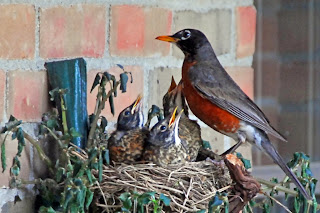
My classroom has the luxury of being equipped with an ActiveBoard. I am planning on using this powerpoint to teach new vocabulary about spring babies. If you don't have a projection screen, Smart Board or ActiveBoard; you can just print, laminate and bind the book for use at circle time or in your library center.
You can download the book here.
Friday, March 20, 2009
Free Printable Emergent Readers
On one of my yahoo groups there has recently been a thread talking about sight word readers.
There are many free resources available on the web.
Here are a few:
Carl's Corner
(Kindergarten emergent readers)
Samples from Reading A-Z
(a few free samples, for $50ish access to all of their books)
Hubbards Cupboard
(40 or so free printable books)
Make Learning Fun
(not all sight word based, but a lot of emergent themed printables)
Mrs. Meacham's
(awesome page with printables and more links)
Kinderprintables
Marcia's Lesson Links
Mrs. Jones Room
(lots of links to many other resources)
http://www.childcareland.com/free.html
(scroll through and look for "book" in the item descriptions)
http://mrskilburnkiddos.wordpress.com/reading/sight-words/
(scroll down, there are links to books she created in the middle of the post)
There are many free resources available on the web.
Here are a few:
Carl's Corner
(Kindergarten emergent readers)
Samples from Reading A-Z
(a few free samples, for $50ish access to all of their books)
Hubbards Cupboard
(40 or so free printable books)
Make Learning Fun
(not all sight word based, but a lot of emergent themed printables)
Mrs. Meacham's
(awesome page with printables and more links)
Kinderprintables
Marcia's Lesson Links
Mrs. Jones Room
(lots of links to many other resources)
http://www.childcareland.com/free.html
(scroll through and look for "book" in the item descriptions)
http://mrskilburnkiddos.wordpress.com/reading/sight-words/
(scroll down, there are links to books she created in the middle of the post)
Monday, March 9, 2009
Memorable Moment #6..Perspective..
 "It's all a matter of perspective."
"It's all a matter of perspective." I can't remember who said this or where I heard it first, but this week this was certainly proven to be true.
Think about the following scenario from the point of view of the teacher, then think about this scenario from the point of view from the parent.
My friend has a four year old little girl in her self-contained special needs pre-k class. This little girl has developmental delays in the communication and social/emotional domains. We'll call her Lilah.
We were out on the playground and Lilah comes running over to tell the teacher that Billy was climbing up the slide. Her teacher told her thank you for telling me and called Billy over to talk about safety. If someone is climbing up the slide and someone is sliding down the slide, they could crash and get hurt. We always slide down the slide.
What seemed like two minutes later Lilah comes running back and says Bobby is climbing up the slide. The teacher has another discussion, this time with Bobby.
Low and behold, what seems like two minutes later, Lilah, herself, is climbing up the slide. Lilah had a talking to.
My friend wrote a note home telling mom about Lilah tattling on things that were mistakes and then copying the very same mistake. (My friend was rather frustrated...the little girl had clearly known that climbing up the slide was a mistake.)
Lilah's mom wrote a note back. It went something like this: "I am so proud of Lilah. She is talking so much more and noticing other kids more and more. She's finally doing things that other 4 year olds do. Thanks for all you've been teaching her."
Wow! Something that was frustrating to my friend is proof to the child's mom that the child is making progress.
Perspective.........maybe sometimes we need to look at things from a different point of view. When Lilah's mom wrote that note back, we all sat back for a second and then laughed. The lady's got a point! Four year olds tattle and four year olds push the limits. How nice it was to be gently reminded that sometimes frustrating behavior is typical! :-)
Sunday, February 15, 2009
Time/Portfolios...How do you balance?
 I'm finishing my last class for my Pre-K Disabilities Endorsement. This week our discussion has been centered on portfolio construction. There are two common threads upon which most of my classmates agree:
I'm finishing my last class for my Pre-K Disabilities Endorsement. This week our discussion has been centered on portfolio construction. There are two common threads upon which most of my classmates agree:
1) Portfolios are a great way to document student growth.
2) Constructing portfolios takes an enormous amount of teacher time.
In the class I teach at the community college, I am constantly telling my students to ask themselves "So what?" We've learned a new concept. We've been reminded about something we already know, but haven't been implementing. So what? My purpose is in asking them "so what?" is to get them to think about the action component. We can learn many new ideas, but if we don't apply the concept or the theory to our practice, then so what?
So here's my "so what" about portfolio construction.
By no means do I think the students in my class have the greatest portfolio, there are always things at the end of the year that I wish I had done, but my assistant and I are getting better at it each year. The trouble with portfolios is that they are so vague. We have CARE portfolios, work files and portfolios...what goes where and what information is important? How do you categorize information? How do you access information needed daily? Where do you keep it?
I currently have three systems that I think help me organize my data.
1) The student's portfolio (This is 4 inch three ring binder. We put plastic page protectors in it at the beginning of the year. We add work samples inside the page protectors as the year progresses.)
2) The student's work folder (This is a file folder in my desk drawer.)
3) My anecdotal record book (This is a smaller 3 ring binder with page dividers. Each student has a section. I keep this behind my desk so I can easily pull it out at any point in the day and jot down an anecdotal or other data.)
Between the work files, the anecdotal record book and the portfolios, we usually have pretty good examples of the student's skill development and continuing challenges.
Here is the list of things that I keep in my student portfolios:
1)Digital pictures of classroom activities glued to construction paper. The child chooses a picture and then tells about the activity for a language sample. (we do approx 1 per month during small group time...by the end of the year I typically have 8-10 language samples)
2)Self portrait (one at the beginning of the year one at the end...again done during small group time)
3)Work samples from units (we pick 4 units from the year and keep 2 or 3 samples from each of the 4 units. Out of the two or three samples, the student then chooses one of them to talk about/reflect on. We end up with a total of 4 pieces for their student led conference.)
4)Any random/miscellaneous piece that I think really showcases skill development (i.e. one girl was drawing picture about a recent field trip to Mote Marine. I asked her if she could write the sounds for the pictures she was writing she wrote "stnra" and "rjn" (stingray and urchin)...I wasn't planning on keeping that piece when we started the activity,but for her I did because it was such a great example of her writing development. Another boy made the coolest picture of a robot by cutting and gluing scraps when we were making collages. I didn't plan on keeping his when we started but it was such a neat showcase of his fine motor and visual spatial skills that I kept his.)
In work folders I keep the following:
1) Brigance data (This is the assessment inventory that my district is currently using.)
2) Daily reports if the child has one
3) Any notes from home/school
4) Any discipline/referral documentation
5) Copies of IEPs and quarterly progress reports
In my anecdotal record book I keep:
1) Anecdotals (running log from day to day, I file these in the work file at the end of the year)
2) Any RtI data and intervention forms (when we go to CARE I pull the documentation and put it in my work file)
3 things help me the most with portfolios/work files.
1) My assistant rocks! I give her a list of the things I want in the portfolios and approximate time frames and she helps to remind me....we haven't done a language sample in a while, we don't have anything in the portfolio for this unit, etc. She also helps me file work samples during nap time when we have one of those rare days and every child is sleeping.
2) We schedule structured small groups every Tuesday and Thursday so if I need something for the portfolio we can build it into small group lessons during the day.
3) I almost always take at least some portion of my planning time. Pre-k teachers seem to always end up fighting for their plan time. Some teachers don't take it and some teachers can't take it. We need it. I build it into our schedule and take at least a portion of it almost every day. This is when I can look at work samples, file daily reports, write progress reports etc.
What do you include in your portfolios? What systems do you use to help you keep up with the work load? I'd love to hear others' ideas on how to keep authentic examples of student work in practical ways for teachers!
Tuesday, January 27, 2009
The Bamboo Story and Positive Behavior Support

 I'm currently involved in an intensive Positive Behavior Support (PBS) training. Yesterday was the first day of our training and the facilitators were laying the foundation and the ideas that improving challenging behavior and creating a classroom climate for emotional literacy often takes a long time. There are no quick fixes.
I'm currently involved in an intensive Positive Behavior Support (PBS) training. Yesterday was the first day of our training and the facilitators were laying the foundation and the ideas that improving challenging behavior and creating a classroom climate for emotional literacy often takes a long time. There are no quick fixes.This reminded me of the Bamboo Story. A collegue gave me a copy of this story quite a few years ago. It was hanging behind my desk as a gentle reminder for my assistant and me. I have no idea what happened to it. It probably fell down at some point and accidentally got thrown away. I've tried to find the same story online, but to no avail. Here is what I remember and the message I took from the story I received so long ago.
The Bamboo Story:
Once upon a time there was a farmer who planted some bamboo seeds. Each day he diligently cared for his bamboo seeds in the hope that he would see the fruits of his labor in wonderful bamboo growth.
The first year passed with daily care. And yet nothing happened. No bamboo sprouted.
The farmer was undaunted. He continued his daily watering, weeding and care of his bamboo seeds.
The second year passed and nothing happened.
At this point the farmer was beginning to feel discouraged. He had consistently worked; nurturing and caring for his bamboo seeds, and yet he saw no growth.
The third year passed and suddenly his bamboo was growing a foot each m onth. By the end of the year his bamboo was over 12 feet tall! Finally, the farmer had evidence of his growth.
onth. By the end of the year his bamboo was over 12 feet tall! Finally, the farmer had evidence of his growth.
 onth. By the end of the year his bamboo was over 12 feet tall! Finally, the farmer had evidence of his growth.
onth. By the end of the year his bamboo was over 12 feet tall! Finally, the farmer had evidence of his growth.So the question is, did the bamboo grow 12 feet in that final year when the growth was evident and measured? Or did the bamboo grow 12 feet in 3 years through the daily care?
It is said that during the first two years the bamboo IS growing. It is said that the bamboo is growing roots below the ground that are a foundation strong enough to support the future growth spurt. It is said that growth was occuring as the farmer was caring for the seeds, the farmer just couldn't see it.
My recent training in PBS strategies made me think of this story again. Often it takes a long time for children with challenging behaviors to demonstrate skills of regulating their own behavior, resolving conflict or problem solving.
So as we begin our journey with positive behavior support, we as teachers must persist as the farmer did. Continually providing the daily care and nurturing of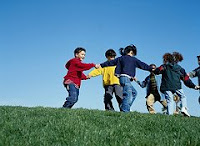 our students' emotional literacy. Those students may leave our classrooms without us seeing evidence of their growth. But perhaps, they grow by leaps and bounds one year. Perhaps those years of daily care including work on emotional vocabulary, directly and indirectly teaching social skills and providing support was a foundation for that growth. And perhaps the child's skills grew over the course of several years, but we just saw evidence of it in one.
our students' emotional literacy. Those students may leave our classrooms without us seeing evidence of their growth. But perhaps, they grow by leaps and bounds one year. Perhaps those years of daily care including work on emotional vocabulary, directly and indirectly teaching social skills and providing support was a foundation for that growth. And perhaps the child's skills grew over the course of several years, but we just saw evidence of it in one.
 our students' emotional literacy. Those students may leave our classrooms without us seeing evidence of their growth. But perhaps, they grow by leaps and bounds one year. Perhaps those years of daily care including work on emotional vocabulary, directly and indirectly teaching social skills and providing support was a foundation for that growth. And perhaps the child's skills grew over the course of several years, but we just saw evidence of it in one.
our students' emotional literacy. Those students may leave our classrooms without us seeing evidence of their growth. But perhaps, they grow by leaps and bounds one year. Perhaps those years of daily care including work on emotional vocabulary, directly and indirectly teaching social skills and providing support was a foundation for that growth. And perhaps the child's skills grew over the course of several years, but we just saw evidence of it in one.Monday, January 12, 2009
Block Play
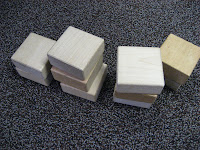
Today was a great day. Not only did I get to hear Ron Clark speak this morning, but this afternoon, my assistant and I actually finished a project that has been on our to do list for two years. Hooray for us!
We have have been wanting to create a book that will provide visual support for children playing in the block area.


We have a few students who have difficulty figuring out what to do and how to play in the block area. Often one of us will play with the students and help them make choices and decisions. But just as frequently, we are working in other areas of the classroom and students are independently playing in the block area. By creating the book, we are hoping to make the area more accessible to more students.
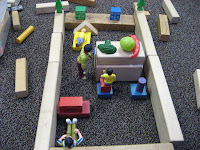

We started off with the resource book "Beyond Centers and Circle Time." There is an excellent section on "Construction Play" that includes an observation scale of simple to complex block structures.
We used this scale to reproduce some similar structures using our classroom materials. We tried to create structures of varying complexity so that children of varying ability levels could use the idea book. We then took pictures with our digital camera and uploaded the images to a PowerPoint. The book was then printed, laminated, bound and placed in the block area. You can download our book here.
We also only used a few pictures within the book. The concept of the book is to help the child get started, not to dictate or direct his/her play. (The pictures on the right are a few that we used in the book.)
Since we haven't used it yet, I'll have to update you on the level of success. Hopefully, we can teach our students how to use the book and then increase levels of self directed play and independence.
Saturday, January 3, 2009
File Sharing and Visual Supports
A few people have mentioned that they are interested in seeing some of the resources that my friend Shannon and I used when we presented our workshop session at the Florida Council for Exceptional Children Conference.
I have uploaded a few of them at 4shared.com.
FCEC Visual Supports PowerPoint
Instructions for Make It/Take It items.
First/Then
Independent Goal Templates
Rule Board
I have uploaded a few of them at 4shared.com.
FCEC Visual Supports PowerPoint
Instructions for Make It/Take It items.
First/Then
Independent Goal Templates
Rule Board
Learning Treasures
Belinda Mooney recently wrote a post about sharing blogs.
If you have clicked on any of the links that I have included in my Pirate Lessons post, you may have already seen some of the great ideas and materials that she posts on her websites.
If you're looking for printables or ideas check out her site, Learning Treasures.
If you have clicked on any of the links that I have included in my Pirate Lessons post, you may have already seen some of the great ideas and materials that she posts on her websites.
If you're looking for printables or ideas check out her site, Learning Treasures.
Subscribe to:
Posts (Atom)





